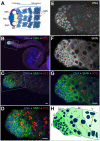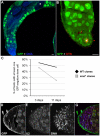Survival motor neuron protein regulates stem cell division, proliferation, and differentiation in Drosophila
- PMID: 21490958
- PMCID: PMC3072375
- DOI: 10.1371/journal.pgen.1002030
Survival motor neuron protein regulates stem cell division, proliferation, and differentiation in Drosophila
Abstract
Spinal muscular atrophy is a severe neurogenic disease that is caused by mutations in the human survival motor neuron 1 (SMN1) gene. SMN protein is required for the assembly of small nuclear ribonucleoproteins and a dramatic reduction of the protein leads to cell death. It is currently unknown how the reduction of this ubiquitously essential protein can lead to tissue-specific abnormalities. In addition, it is still not known whether the disease is caused by developmental or degenerative defects. Using the Drosophila system, we show that SMN is enriched in postembryonic neuroblasts and forms a concentration gradient in the differentiating progeny. In addition to the developing Drosophila larval CNS, Drosophila larval and adult testes have a striking SMN gradient. When SMN is reduced in postembryonic neuroblasts using MARCM clonal analysis, cell proliferation and clone formation defects occur. These SMN mutant neuroblasts fail to correctly localise Miranda and have reduced levels of snRNAs. When SMN is removed, germline stem cells are lost more frequently. We also show that changes in SMN levels can disrupt the correct timing of cell differentiation. We conclude that highly regulated SMN levels are essential to drive timely cell proliferation and cell differentiation.
Conflict of interest statement
The authors have declared that no competing interests exist.
Figures









Similar articles
-
Intimate functional interactions between TGS1 and the Smn complex revealed by an analysis of the Drosophila eye development.PLoS Genet. 2020 May 26;16(5):e1008815. doi: 10.1371/journal.pgen.1008815. eCollection 2020 May. PLoS Genet. 2020. PMID: 32453722 Free PMC article.
-
The Snail protein family regulates neuroblast expression of inscuteable and string, genes involved in asymmetry and cell division in Drosophila.Development. 2001 Dec;128(23):4757-67. doi: 10.1242/dev.128.23.4757. Development. 2001. PMID: 11731456
-
Polycomb group genes are required for neural stem cell survival in postembryonic neurogenesis of Drosophila.Development. 2007 Mar;134(6):1091-9. doi: 10.1242/dev.02793. Epub 2007 Feb 7. Development. 2007. PMID: 17287254
-
SMN control of RNP assembly: from post-transcriptional gene regulation to motor neuron disease.Semin Cell Dev Biol. 2014 Aug;32:22-9. doi: 10.1016/j.semcdb.2014.04.026. Epub 2014 Apr 24. Semin Cell Dev Biol. 2014. PMID: 24769255 Free PMC article. Review.
-
Spinal muscular atrophy: the role of SMN in axonal mRNA regulation.Brain Res. 2012 Jun 26;1462:81-92. doi: 10.1016/j.brainres.2012.01.044. Epub 2012 Jan 28. Brain Res. 2012. PMID: 22330725 Free PMC article. Review.
Cited by
-
Analysis of asymptomatic Drosophila models for ALS and SMA reveals convergent impact on functional protein complexes linked to neuro-muscular degeneration.BMC Genomics. 2023 Sep 27;24(1):576. doi: 10.1186/s12864-023-09562-4. BMC Genomics. 2023. PMID: 37759179 Free PMC article.
-
A nerve-wracking buzz: lessons from Drosophila models of peripheral neuropathy and axon degeneration.Front Aging Neurosci. 2023 Aug 8;15:1166146. doi: 10.3389/fnagi.2023.1166146. eCollection 2023. Front Aging Neurosci. 2023. PMID: 37614471 Free PMC article. Review.
-
Spinal Muscular Atrophy Patient iPSC-Derived Motor Neurons Have Reduced Expression of Proteins Important in Neuronal Development.Front Cell Neurosci. 2016 Jan 11;9:506. doi: 10.3389/fncel.2015.00506. eCollection 2015. Front Cell Neurosci. 2016. PMID: 26793058 Free PMC article.
-
Survival Motor Neuron Protein Participates in Mouse Germ Cell Development and Spermatogonium Maintenance.Int J Mol Sci. 2020 Jan 25;21(3):794. doi: 10.3390/ijms21030794. Int J Mol Sci. 2020. PMID: 31991812 Free PMC article.
-
The neuroprotective drug riluzole acts via small conductance Ca2+-activated K+ channels to ameliorate defects in spinal muscular atrophy models.J Neurosci. 2013 Apr 10;33(15):6557-62. doi: 10.1523/JNEUROSCI.1536-12.2013. J Neurosci. 2013. PMID: 23575853 Free PMC article.
References
-
- Wirth B. An update of the mutation spectrum of the survival motor neuron gene (SMN1) in autosomal recessive spinal muscular atrophy (SMA). Hum Mutat. 2000;15:228–237. - PubMed
-
- Brzustowicz LM, Lehner T, Castilla LH, Penchaszadeh GK, Wilhelmsen KC, et al. Genetic mapping of chronic childhood-onset spinal muscular atrophy to chromosome 5q11.2-13.3. Nature. 1990;344:540–541. - PubMed
-
- Lefebvre S, Burglen L, Reboullet S, Clermont O, Burlet P, et al. Identification and characterization of a spinal muscular atrophy-determining gene. Cell. 1995;80:155–165. - PubMed
-
- Monani UR, Lorson CL, Parsons DW, Prior TW, Androphy EJ, et al. A single nucleotide difference that alters splicing patterns distinguishes the SMA gene SMN1 from the copy gene SMN2. Hum Mol Genet. 1999;8:1177–1183. - PubMed
-
- Lorson CL, Androphy EJ. An exonic enhancer is required for inclusion of an essential exon in the SMA-determining gene SMN. Hum Mol Genet. 2000;9:259–265. - PubMed
Publication types
MeSH terms
Substances
Grants and funding
LinkOut - more resources
Full Text Sources
Other Literature Sources
Medical
Molecular Biology Databases

